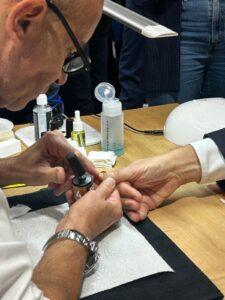Cash is now used for only a fifth of payments in the UK, but are payment cards also heading for a decline? Ian Horne speaks to Terrie Smith, co-founder of Digiseq.
Paytech – payment technology – is an area we rarely cover in our WealthTech newsletter. It is a sector that will have a profound impact on our relationship with money, however, so financial advisers and wealth managers may well have an interest in how it is evolving – even if just from a personal perspective.
The development I want to focus on here is ‘wearable payments’. Wearable payments represent a colourful collision between the world of payments and fashion, whereby chipped items of clothing and jewellery can be used to pay for your coffee, train fare or whatever you like, instead of your bank card. Many people already do this with their watches, but there is still a window of opportunity to confuse the hell out of people by paying with a ring, a cufflink or even a long-sleeved shirt.
The wearable payments market is expected to grow quickly, though estimates of its potential size vary. Grand View Research valued it in 2020 at $10.3bn (£8.46bn) globally, with a revenue forecast for 2028 of $80.4bn. Allied Market Research, however, valued it in 2019 at $285bn, forecasting a $1.37tn market by 2027. If someone can explain the discrepancy, please let me know.
A payment network ‘like Uber or Airbnb’
To shed some light on wearable payments, I spoke to Terrie Smith (pictured below), co-founder of, and global ambassador for, wearable payment enabler Digiseq. Smith has more than 20 years’ experience in the industry and in a previous position played a key role in creating and developing the Mastercard digital enable system used to support Apple Pay.
‘What we’ve created is a network,’ says Smith. ‘It’s more like Uber or Airbnb.’
This network is not just about payment, she says.
‘We will connect the consumer to an object to a service. The consumer might buy a bracelet and then they might want to put payment on it, or they might want to put access to their house on it.’
The network also allows people to create digital verifications to establish the provenance of an item, in particular luxury goods.
What Digiseq is creating, then, is a network that allows you to scan items of clothing for various activities. I could write at length about this, but with payment being arguably the core feature of it, I will focus on that aspect. My main question is this: will our shiny bank cards become obsolete?
Is this the end of the bank card?
‘We believe really strongly in choice,’ says Smith, although she does predict the demise of card payments.
‘I believe card payment is going to be phased out. The reason for that, I think, is that people use their mobile, and that’s where it’s going. The mobile doesn’t work in every situation, nor does it work for everything, nor does it give you the security and knowledge that your object is always ready to pay. And so we believe that fashion and technology have an opportunity to meet.’
While I am aware this trail of logic will be part of Digiseq’s elevator pitch, it is correct to note that mobile payments are of little use if your battery is dead. Similarly, as someone who can’t be bothered with the QR code key fobs, I can easily identify with the dread of waiting for a supermarket loyalty code to load while an impatient line of shoppers gathers behind me.
These devices are designed to work offline too, so you can use them in any digital wasteland with no Wi-Fi. For instance, the Orkney Islands, which reportedly has the worst internet connection in the UK, or the Morrisons in Peckham, which appears to have similar problems.
There are other benefits to wearable payments. For most people, the process of reaching into your pocket for a card is far from troublesome. For those with accessibility issues though, the ability to scan a bracelet or watch could make life easier. Smith confirms that this is particularly useful on the London underground during rush hour.
‘This will complement the phone. It’s not going to replace a phone but I think it will entirely replace the card,’ says Smith.
Data privacy and lost devices
There are a few concerns, of course. The first is data privacy and whether we want a device with the potential to track and measure so much of our activity. Smith says all data taken from the bank is encrypted and that even her chief technology officer would be unable to access it.
I also ask what happens if you lose your wearable device. Smith says the best next step would be to switch it off. This would work in a similar manner to calling your bank if your card went missing.
You might also be wondering how the information from a bank card gets into a wearable. Smith says that cards can be downloaded to an object via your phone, which sounds straightforward, and makes me wonder if we can phase out the lengthy wait that can occur when a new payment card and pin are being posted.
It remains to be seen what impact these developments have on personal finance, although ease of spending presumably means more spending. In terms of the evolution of payment preferences, UK Finance found that almost a third of the UK population was registered for mobile payments in 2020, up 75% from the previous year. The thought of using your phone for payments seemed wild not so long ago, so it is not unreasonable to think that wearable payments could be commonplace before long.
The death of the card? Let’s see.

